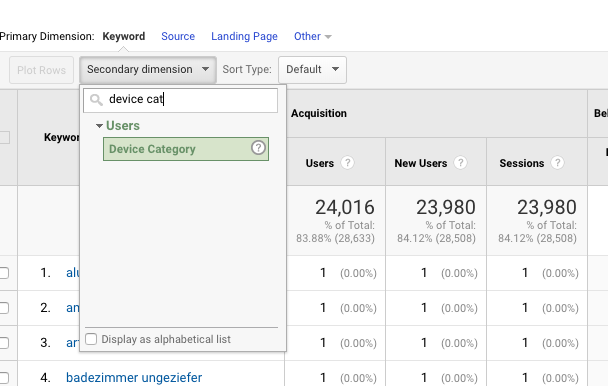Maximizing Search Engine Optimization with Secondary Dimension in Google Analytics
Maximizing Search Engine Optimization with Secondary Dimension in Google Analytics
Blog Article
Unlock Deeper Insights With Second Measurement in Google Analytics
With the huge area of data available in Google Analytics, the usage of secondary dimensions can substantially enrich your logical capabilities. These added layers of data supply a nuanced perspective that can light up complex details within your key metrics. By tactically integrating secondary measurements right into your analysis, you can uncover beneficial understandings that could otherwise remain obscure. The ability to interpret and divide user actions with greater accuracy opens up a world of possibilities for boosting and optimizing methods efficiency.
Recognizing Primary Vs. Additional Measurements
On the other hand, second dimensions allow you to additional dissect your main dimension information. By adding a second dimension, you can layer on added info to your primary measurement, making it possible for a much more granular analysis. If your main dimension is the source/medium with which individuals arrived on your website, adding a second measurement like geographic place can disclose where those users are situated geographically.
Making Use Of Additional Measurements Effectively
Properly using secondary dimensions in Google Analytics boosts the depth and granularity of data analysis, supplying beneficial insights into individual actions and fads. By integrating second dimensions along with main measurements, experts and online marketers can dive deeper right into the specifics of user interactions on their sites. Second measurements allow users to sector and filter primary measurement information additionally, providing a much more detailed view of user actions, communications, and demographics. This can be especially beneficial when attempting to comprehend the effect of certain variables on individual engagement, such as the browsers or tools they are making use of, the sources of their web traffic, or their geographical locations.
Moreover, second dimensions enable individuals to contrast and contrast different information points within a single record, promoting a much more extensive analysis of user actions patterns. By leveraging additional dimensions successfully, companies can discover concealed insights, enhance their advertising and marketing methods, and improve the overall customer experience on their sites.
Checking Out Common Second Measurement Combinations
To better examine user habits and trends in Google Analytics, it is valuable to explore usual combinations of additional measurements. By integrating different additional dimensions, marketing professionals and analysts can gain deeper understandings right into exactly how various variables influence and interact internet site efficiency. Some usual additional dimension combinations that give important insights include assessing web traffic resources with user places to comprehend where web site site visitors are originating from geographically and just how they discovered the website. Similarly, combining touchdown pages with gadgets can expose which web pages perform best on various devices, assisting in enhancing the website for better customer experience. Checking out customer actions metrics with second dimensions such as passions or demographics can aid in targeting certain audience sections extra successfully. By exploring these usual additional dimension mixes, companies can discover hidden patterns, recognize chances for renovation, and make data-driven choices to boost their on-line existence.
Using Additional Measurement in Customized Information
Making use of secondary measurements in customized reports permits for a much more detailed analysis of data in Google Analytics, improving the deepness of understandings acquired. When developing customized reports in Google Analytics, incorporating second dimensions can give a much more in-depth sight of how numerous dimensions communicate with each other. This feature enables users to delve deeper into their data and uncover important relationships that may not be right away top article noticeable.
By using secondary measurements in custom records, customers can acquire a much better understanding of their website or application web traffic. Incorporating the main dimension of "source/medium" with the secondary measurement of "touchdown web page" can reveal which touchdown web pages are performing ideal for traffic coming from details sources. This insight can help marketing professionals optimize their projects and improve total conversion rates.

Enhancing Data Visualization With Additional Dimension
When discovering data in Google Analytics custom records, including secondary measurements not only provides a much more detailed analysis yet also enhances the graph of understandings via data visualization. By including a secondary measurement to your records, you can enrich the method information is offered, making it simpler to recognize patterns, trends, and connections within your internet site's performance metrics.
Secondary dimensions can aid you section your information even more, permitting a deeper understanding of user actions and interactions on your website. When attempting to isolate specific variables that might impact your site's performance., this enhanced level of granularity can be particularly helpful.

Verdict
To conclude, leveraging secondary measurements in Google Analytics permits a much more comprehensive evaluation of data, resulting in deeper understandings and more informed decision-making. Secondary Dimension in Google Analytics. By including added layers of details to key pop over to these guys information sets, marketing professionals and analysts can discover hidden trends, patterns, and relationships that offer a granular view of individual actions and interactions. This boosted degree of insight allows optimization of campaigns and customized methods for particular target market sections, ultimately boosting performance and conversion prices
On the other hand, secondary dimensions permit you to additional study your key measurement data. learn the facts here now By adding a secondary dimension, you can layer on added information to your primary measurement, making it possible for a more granular analysis. If your key dimension is the source/medium with which individuals showed up on your site, including a second measurement like geographical location can reveal where those individuals are situated geographically. By including secondary dimensions together with key dimensions, analysts and marketers can dive deeper right into the specifics of user communications on their sites. Additional measurements allow customers to segment and filter key measurement information better, offering a much more in-depth view of customer habits, communications, and demographics.
Report this page